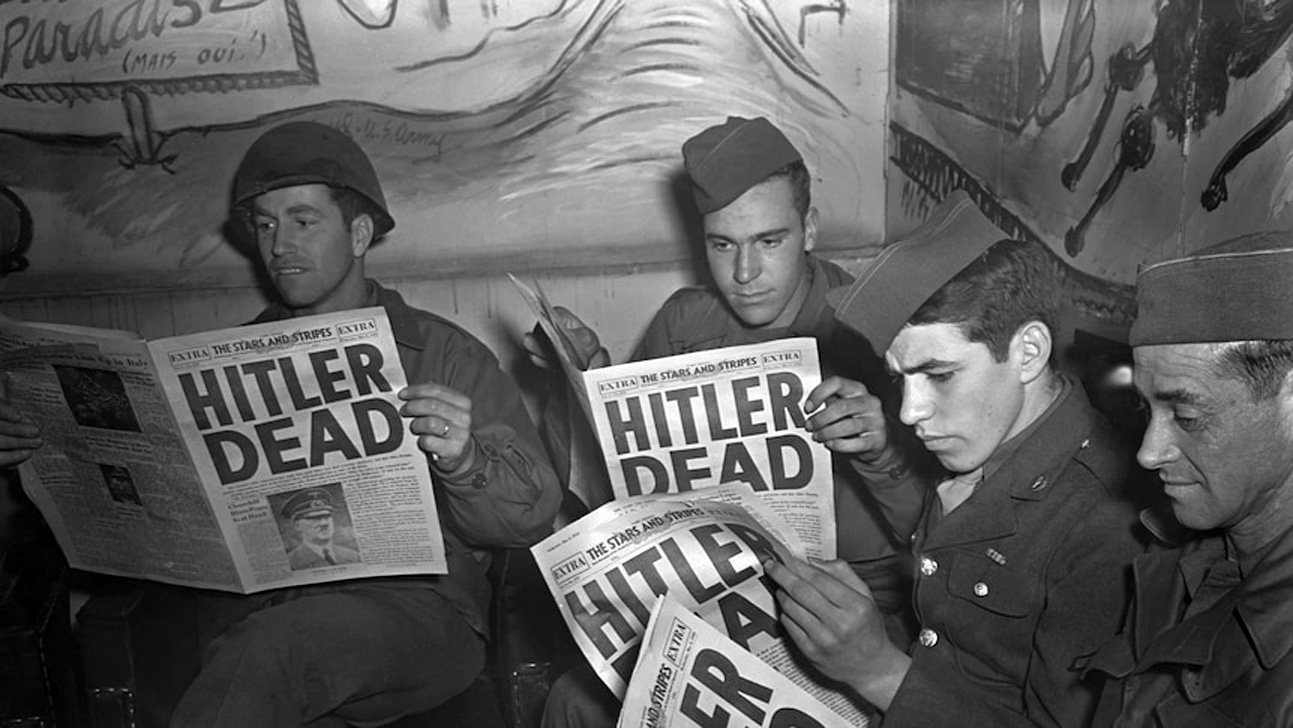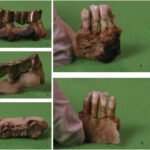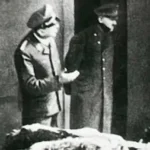This year marks the 80th anniversary of Adolf Hitler’s suicide and the end of the Second World War. Over the next ten posts, we will walk through his final ten days, day by day, based on eyewitness testimony, physical evidence, and primary-source documentation to show how we know, beyond any reasonable doubt, that Hitler took his own life in his Berlin bunker on April 30, 1945.
Before we get to the day-by-day breakdown, let’s take a few minutes to address the persistent and deliberately dishonest claims that:
- Hitler wanted to escape.
- Hitler could have escaped without leaving any evidence.
- there is a lack of evidence of what “really” happened.
None of this is true.
Hunting Hitler and the So-Called History Channel
The so-called History Channel began whipping up sensationalistic and misleading stories about Hitler escaping Germany years before their three-season series, Hunting Hitler, came along. But that show was their most successful piece of fake and dangerous history to date. Each of their shows on the subject tries hard to present their work as an investigation of the truth. In reality, however, they are all rooted in disinformation for profit and they train viewers to distrust history; replacing evidence with innuendo. They encourage and thrive on the conspiracy theorist belief that the “official story” is likely wrong, and speculative nonsense deserves equal consideration. Worst of all, they flat out lie.
As I’ve said before, the logic and methodology of Hunting Hitler is no different than Holocaust denial. Both start by dismissing well-documented historical facts and replacing them with a politically charged fantasy. Both treat eyewitness testimony as suspicious unless it supports their theory. And both conceal or distort the evidence in service of a predetermined conclusion.
The Skull Story and the Jawbone
One of the most common arguments made by conspiracy theorists is the so-called “female skull” story. In 2009, an American researcher claimed that a piece of skull long housed in Russian archives and allegedly belonging to Hitler was actually that of a woman. This was treated in some circles as a bombshell, but it never should have been.
That skull fragment wasn’t even found until almost a year after the Soviets had already recovered Hitler’s remains. It was located in a general area near the Chancellery but not in the exact location where Hitler’s body had been burned, and not with any clear chain of custody. It sat in Soviet archives for years, largely unlabeled, until someone arbitrarily asserted it was Hitler’s. When later scientific testing showed the bone came from a woman, it merely confirmed that a misattributed fragment was misattributed. It changes nothing.
The actual forensic evidence is the lower jawbone, recovered almost immediately after the fall of the Führerbunker. The Soviets found it at the scene and confirmed it against dental records using Hitler’s own dental staff—his dentist’s assistant Käthe Heusermann and technician Fritz Echtmann, both of whom were captured, interrogated, and independently verified the match. This identification has been reaffirmed in two peer-reviewed scientific studies. It is clear. It is physical. And it is conclusive.
Bob is No Hero
Hunting Hitler’s central figure, Bob Baer, is a good example of how conspiracy culture has wormed its way into mainstream respectability. Baer is treated as an expert and a good guy because of his CIA credentials and his hostility to the Bush Administration’s actions after 9-11, but he has made contradictory and irresponsible statements across platforms, scoffing at falsehoods on CNN while promoting conspiracy paranoia with Alex Jones. He plays both sides, depending on the audience. That’s not skepticism; it’s opportunism.
We’ve seen this kind of character before. Baer, who was presented as a hero when George Clooney played him (as Bob Barnes) in Syriana (2005), reminds me of L. Fletcher Prouty, the real-life model for the “Mr. X” character in Oliver Stone’s JFK. Prouty was a former military intelligence officer whose claims were always wildly suspect, but it wasn’t until his connections to Holocaust denial circles came to light that people began questioning his credibility. Baer hasn’t gone quite that far, but his willingness to entertain baseless 9-11 claims is part of the same pattern: exaggerate your access and knowledge, push doubt as insight, and never commit to the evidence.
To understand the depths of Baer’s disrespect of facts and history, consider how Hunting Hitler tried to pass off a photo of Moe Howard, from The Three Stooges, as a photo of Hitler in South America.
The Flight That Didn’t Happen
One of Hunting Hitler’s most misleading claims is that Hitler may have escaped Berlin by air on one of the last flights out of Tempelhof Airport on April 25, 1945. After running around in the Berlin subway system, looking for allegedly lost tunnels that Hitler could have used to get to the airport, they cite the evacuation of personal items, artwork, and furniture to Hitler’s Berchtesgaden home as suspicious, as if sending property south implies that the sender planned to go as well.
This is nonsense. Sending property proves nothing. What we do know is that Hanna Reitsch and General Ritter von Greim flew into Berlin on April 26, not out. If Hitler had escaped the day before, he wouldn’t have been there to meet them—yet both testified to seeing and speaking with him. Reitsch lived until 1979 and never recanted her account. She remained proud of her actions in Hitler’s service. That’s not a cover-up. That’s corroboration.
And let’s not forget: one of Hitler’s aircraft carrying his personal items was shot down, and the contents were later recovered and auctioned off. So much for a grand escape.
Testimonies—Loyal and Regretful Alike
What makes the confirmation even stronger is that those who witnessed Hitler’s final days—regardless of whether they stayed loyal to him or came to regret ever working for him—all told the same story.
Take Hanna Reitsch, the devoted Nazi test pilot who flew into Berlin on April 26 and later bragged about her role in those final days. She insisted Hitler never left Berlin and described his suicide preparations.
And then there’s Traudl Junge, one of Hitler’s secretaries. She was just 25 when she typed his final will and testament. After the war, she was deeply ashamed of her involvement with Hitler, describing how she had once worshipped him and came to see the full horror of what he had done. Yet her account of those final days matches Reitsch’s in every essential detail.
They had opposite moral trajectories—but told the same story.
As did others. The Soviets conducted an extensive investigation, interrogated multiple witnesses—including Hitler’s aide Otto Günsche and bodyguard Rochus Misch, who spent more than a decade in Soviet custody—and none of them changed their story. There was nothing to change. The accounts were consistent because they were true.
What’s Ahead
This multi-part blog series will lay out the final days of Hitler’s life in Berlin, beginning with his 56th birthday on April 20 and ending with his suicide on April 30. Each post draws on known evidence, documented testimony, and the careful work of historians, not conspiracy media.
The truth is not hidden. The truth is not in dispute. The truth is this:
Hitler killed himself in the Führerbunker on April 30, 1945.
It’s time we stopped pretending there’s any serious doubt about that.
FULL SERIES:
Yes, Hitler Really Did Commit Suicide, 80 Years Ago
Part 1: April 20, 1945 – Hitler’s Last Birthday
Part 2: April 21, 1945 – The Net Tightens
Part 3: April 22, 1945 – The Breaking Point
Part 4: April 23, 1945 – The Succession Panic
Part 5: April 24, 1945 – The Axis of Betrayal
Part 6: April 25, 1945 – No Way Out
Part 7: April 26, 1945 – The Sky Closes
Part 8: April 27, 1945 – Rienzi
Part 9: April 28, 1945 – Wedding Day
Part 10: April 29, 1945 – The Day Before the End













Leave a Reply